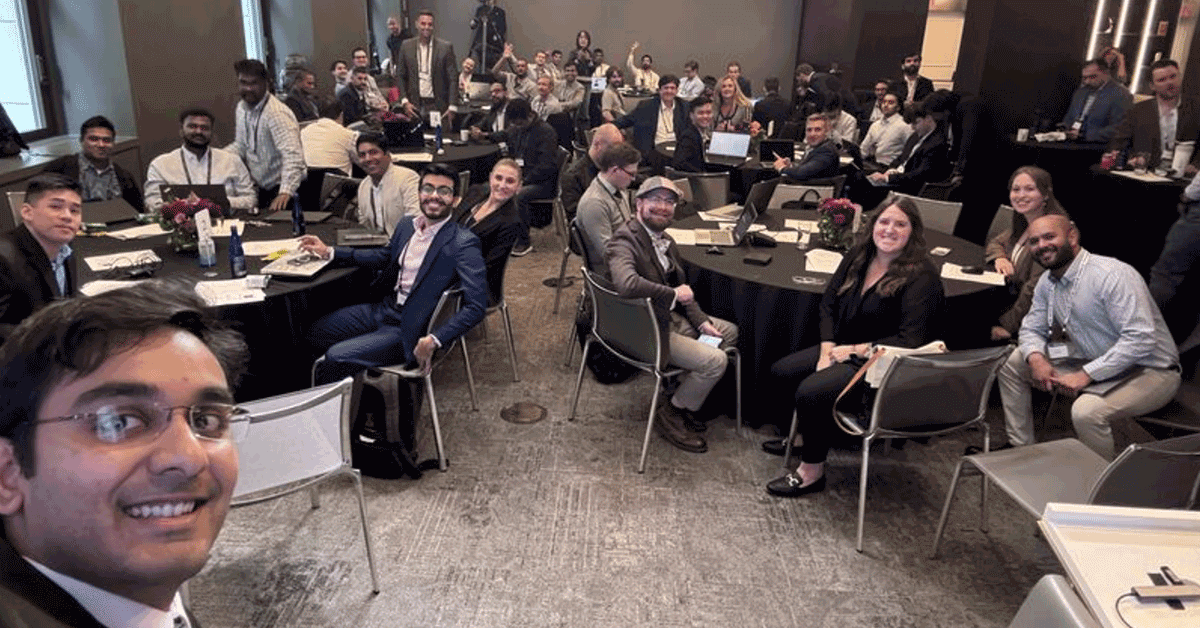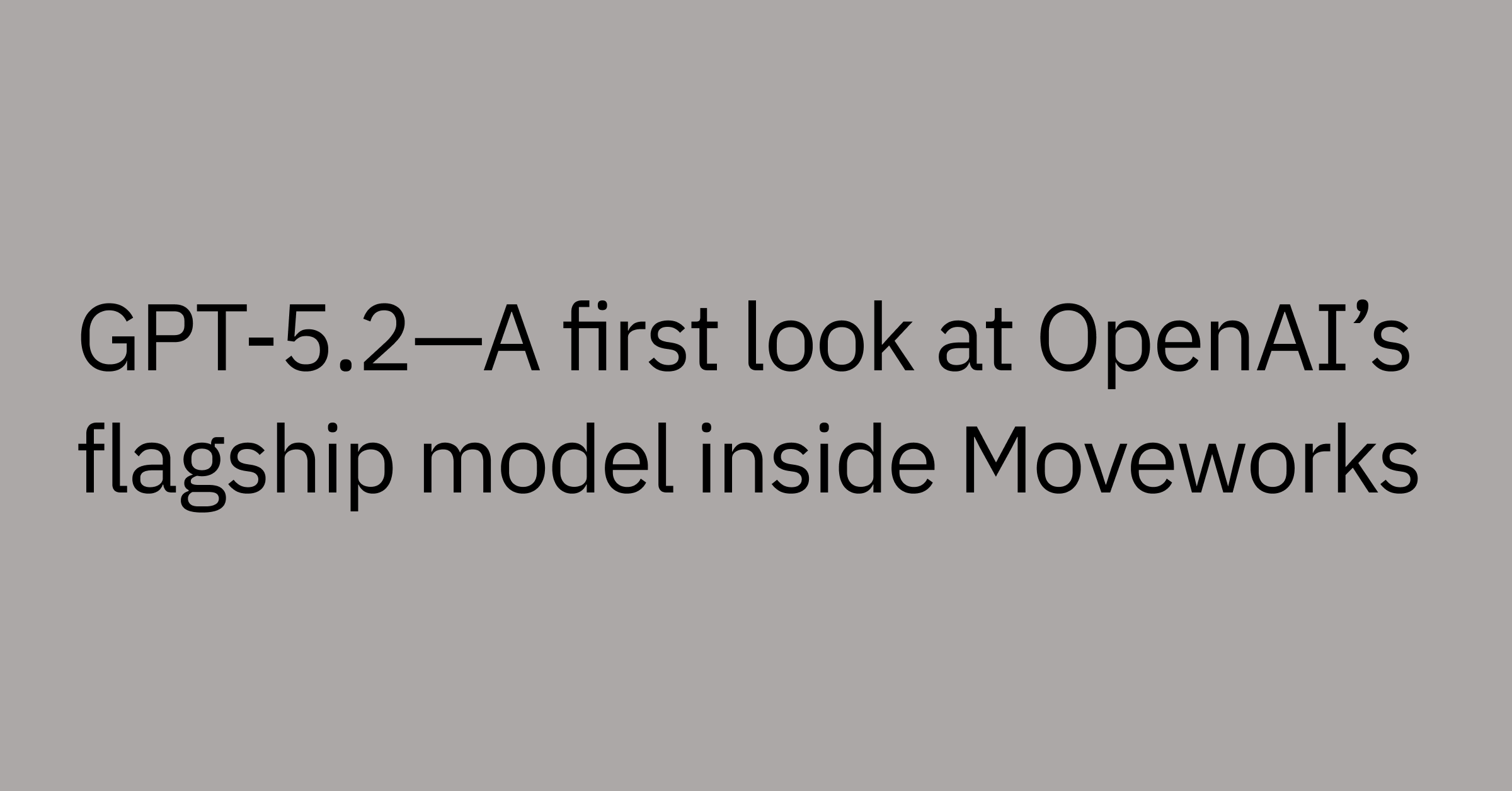Table of contents
In case you missed it, earlier this month we launched the Agentic Automation Engine – a groundbreaking new platform for building AI Agents in our developer platform, Agent Studio. Our vision for Agent Studio was always to empower developers to build AI agents for every business system, but those agents were historically powered by middleware & iPaaS tools. Since those tools weren’t designed for building AI agents, we noticed that it took a lot of code to build those AI agents. Worse, the AI agents built with these tools didn’t seem to perform as well as developers hoped – resulting in less powerful AI agents.
However, our new Agentic Automation Engine is designed from its core to build AI agents, so it can build much more powerful AI agents with much less code. This is because of the four new capabilities that power our Agentic Automation Engine – Manifest Generator, Slot Resolvers, Policy Validators, and the Action Orchestrator. You can learn more about these technologies in our white paper.
Agent Studio is still where you go to build and extend AI agents, but it’s now powered by a more powerful AI engine. It’s like upgrading from a bicycle to a self-driving sports car. You’re still getting from point A to point B, but now the vehicle does the heavy lifting, moving faster and smoother with less effort on your part.
Big promise? We agree. That’s why as a sneak peek ahead of our live event for Agentic Automation, we gave 50+ developers a first look at the new platform at our New York Stock Exchange hackathon.

You can hear what some of the developers had to say in our Agentic webinar (Spoiler alert: they loved it). More importantly, we want to share just how powerful these AI agents are and how simple it was to build them. So we’re going to give you a sneak peak into the AI agents that were built during (and shortly thereafter) the hackathon.
Five game-changing AI agents
We’re going to cover five AI agents that are more powerful and can be built much easier today because of the Agentic Automation Engine, summarized in the table below.
Plugin | Purpose | Before Agentic Automation | Potential After Agentic Automation |
PTO Reporting for Managers | Allows managers to receive PTO reports for multiple employees. | 200+ lines of code, 2-3 hours to build, parsing emails and managing loops manually. | 20 lines of code, built in 10 minutes with Slot Resolvers automating the parsing. |
Salesforce Record Filtering | Filters Salesforce records based on various criteria, such as account and owner. | Multiple plugins required for different search patterns, days to build fully functional systems. | Single plugin handles multiple search scenarios, reducing development time significantly. |
Diagram Generation | Automatically generates diagrams based on content or data provided by users. | Very high effort, previously not feasible without manual coding and complex workflows. | Automated using LLM actions and Mermaid syntax generation, much lower effort and fully automated process. |
Link Shortener | Automates the process of creating unique short links and managing approvals. | Manual link creation, approval process required, multiple steps needed for validation and updates. | Fully automated with Action Orchestrator managing approvals, link creation, and progress updates. |
Major Incident Ticket Clean-up | Automates the process of linking multiple IT tickets to a major incident in IT service management. | Hours of manual work to classify and link hundreds or thousands of tickets. | Automated classification, linking, and notifications using Slot Resolvers and Action Orchestrator, faster. |
Plugin #1: PTO Reporting for Managers
Our original version of Agent Studio was able to help users look up their PTO balances, but now managers can get reports for multiple team members.
In a world without slot resolvers, users had to parse everyone’s email as comma-separated strings so iPaaS and middleware knew how to process it. But with Slot Resolvers, the conversation experience is much more efficient. It can convert natural language references to coworkers into business objects and reliably hit the right APIs.
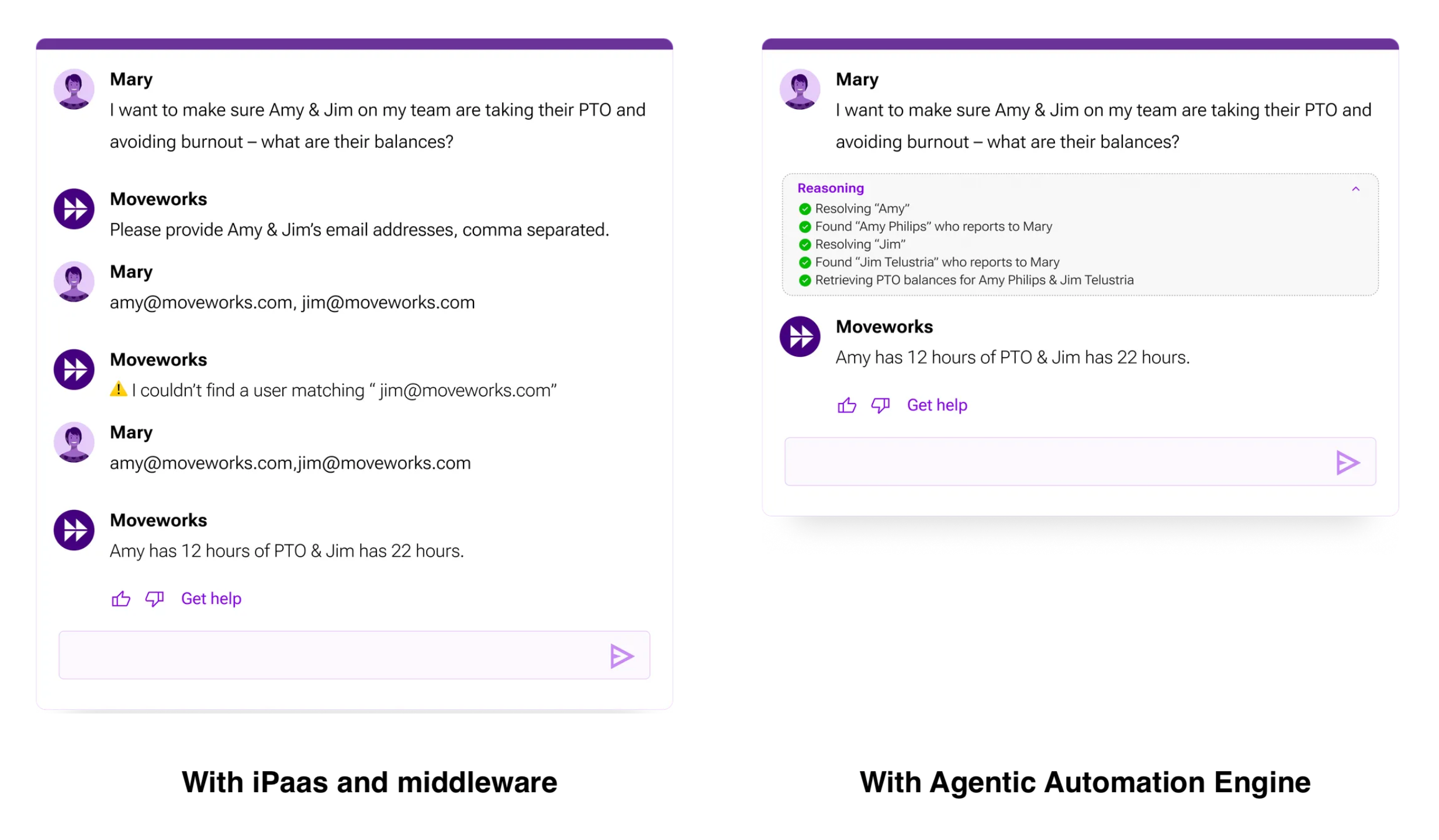
On the backend, our Action Orchestrator added value to the developer’s experience:
It brought XML-based HTTP actions to Agent Studio, which means that we were able to hit a Workday XML SOAP API, in this case without the need for an iPaaS tool.
It used a “for loop” control flow to execute the HTTP action for each user that was resolved.
It sent progress update notifications back to the user.
By the time you eliminate all the text processing, loop management, progress update notifications and XML conversion from a traditional iPaaS tool, you’ve reduced a lot of tech debt by going from ~200 lines of code to ~20 lines of code, not to mention the potential productivity gains from building plugins like this in 10 minutes instead of 2-3 hours. With these kinds of outcomes, you might not even need to pay for an iPaaS license
Plugin #2: Salesforce Record Filtering
Salesforce is one of our customer’s favorite business systems to integrate with. There’s an immense wealth of data and information that’s used from account executives to sales leadership to customer success teams.
Unfortunately, prior to the Agentic Automation Engine, it was difficult to input the necessary data into an AI agent, because developers had to build a plugin for every search pattern (i.e: 1 plugin for “show me my accounts,” another plugin for “show me the ACME account”). This process of developing hundreds of plugins took days, and sometimes weeks of work just to be complete enough for an executive demos. And even then, many of these use cases never got to a truly “production-ready” state that was rolled out to all employees.
Coming out of the hackathon, we were thrilled by how robust our new plugins were. A single plugin could now handle a variety of different scenarios.

You can understand the underlying process here through the Reasoning steps, but to clarify it further:
Slot Resolvers provide numerical slot types that convert values like $200K into 200000.0 so they’re ready for APIs.
Slot Resolvers provide user data types that can convert “Jake” to “jake.schnur@moveworks.ai”
Slot Resolvers manage multiple, optional slots. Between these two examples, the same plugin has slots for CountryCode, Owner, ARR – but you aren’t forced to provide them if you don’t want them.
Action Orchestrator provides LLM actions that can generate a Salesforce Object Query Language (SOQL) filter.
Action Orchestrator uses LLM actions and script actions together to calculate a useful statistic about the data.
Action Orchestrator supports advanced citation structures which can return the list of records and the total count – even though they don’t look the same.
Action Orchestrator gracefully deals with error handling and any edge case scenarios returned by the Salesforce API.
Plugin #3: Diagram Generation
At first, this was an ambitious idea and we were doubtful if this would even work. However, with Agentic Automation, it's become clearer to us that the possibilities for AI agents are truly only bounded by our imagination.
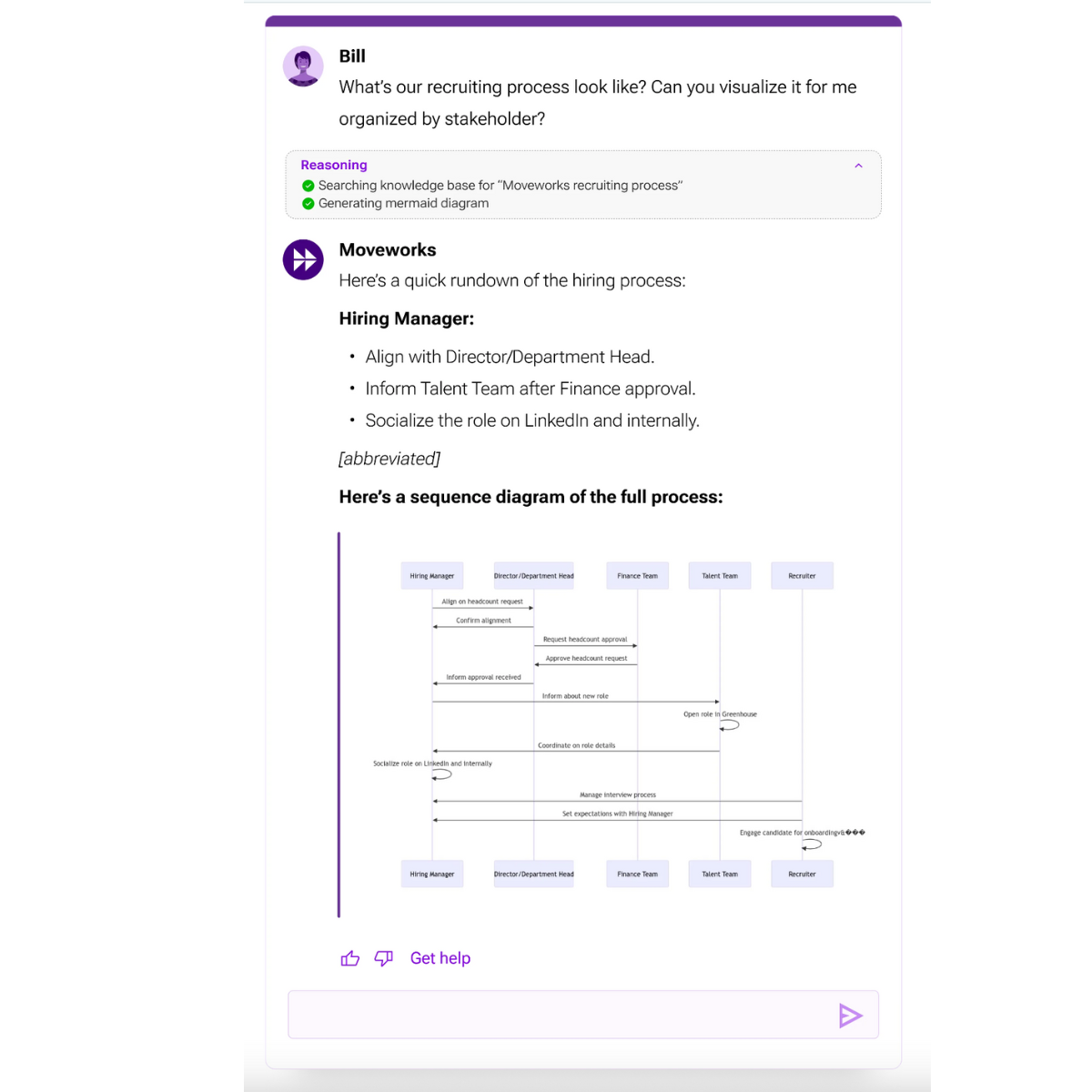
This was an astounding experience for us. Our Agentic Automation Engine and Agentic Reasoning Engine synergistically work together to create a natural conversation experience for generating new diagrams or other visualizations. This experience would have been challenging if not impossible to tocould not have been delivered with an iPaaS tool that was not purpose-built for an Agentic Reasoning Engine.
Our Agentic Reasoning Engine found up-to-date articles about the hiring process at Moveworks
Our Agentic Automation Engine presented model-facing slot descriptions and example values to get a high quality summary of the articles.
Our Action Orchestrator’s LLM actions generated accurate Mermaid syntax (a diagramming language)
Our Action Orchestrator’s Compound actions used our DSL converters to convert Mermaid syntax into an image URL by base64 encoding the mermaid code.
If you want to see this one in action end-to-end, check out our post here.
Plugin #4: Link Shortener
This is one of our new favorite plugins at Moveworks – countless people from our enablement to marketing to product are using this plugin in M8 (our internal Moveworks Copilot) to make it easier to find new resources.
At Moveworks, we own aka.mw and create short links (like aka.mw/plugins) to help our employees and customers get to resources faster.
Registering these links, however, isn’t an instantaneous or straightforward process. Links need to be unique. If you’re replacing an existing link, you need approval to do so. Plus, our vendor’s APIs weren’t exactly designed to be read by humans (they return “aka.mw” and “plugins” as two separate fields rather than a standard link format: aka.mw/plugins).
Before the agentic automation engine, it was confusing to do this in M8. The details of the automation were locked behind the iPaaS so the message to end users was uninformative.
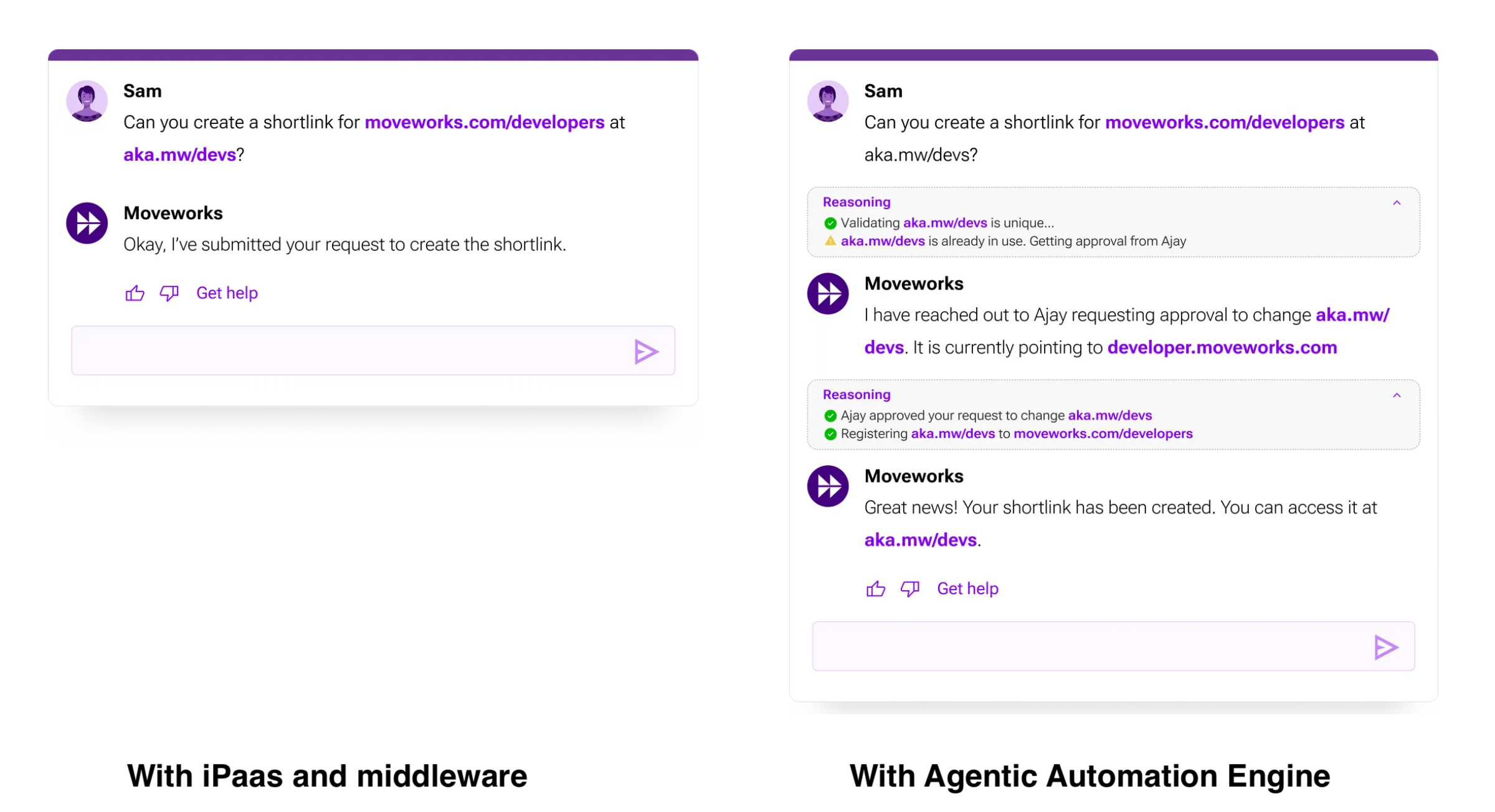
With the Agentic Automation Engine, you’ll notice the plugin experience is much stronger.
The Action Orchestrator understands this is an asynchronous process and shares more useful updates back to the user
The Action Orchestrator collects approvals from the necessary individuals.
The Action Orchestrator has a “if-else” control flow to determine how the plugin should behave if the shortlink is already in use.
The Action Orchestrator’s compound actions and data mapper convert the short link data (”aka.mw” and “devs”) and creates a user-friendly URL (aka.mw/devs).
The Action Orchestrator shares progress updates with the user at each step of the process.
Plugin #5 : Major Incident Ticket Clean Up
For many of our customers, IT service management is a critical focus of their Moveworks investment. They want to find ways to make their service desks more efficient. Some of that starts from providing IT agents with access to AI agents that make their lives easier.
Whenever an outage occurs, IT agents are overwhelmed with hundreds, if not thousands, of IT tickets all about the same outage. To keep themselves organized, they typically create a “major incident” to track the outage and link all these tickets to the outage ticket – but this process takes hours to read every single ticket, determine if it’s related to the outage, and link it to the major incident.
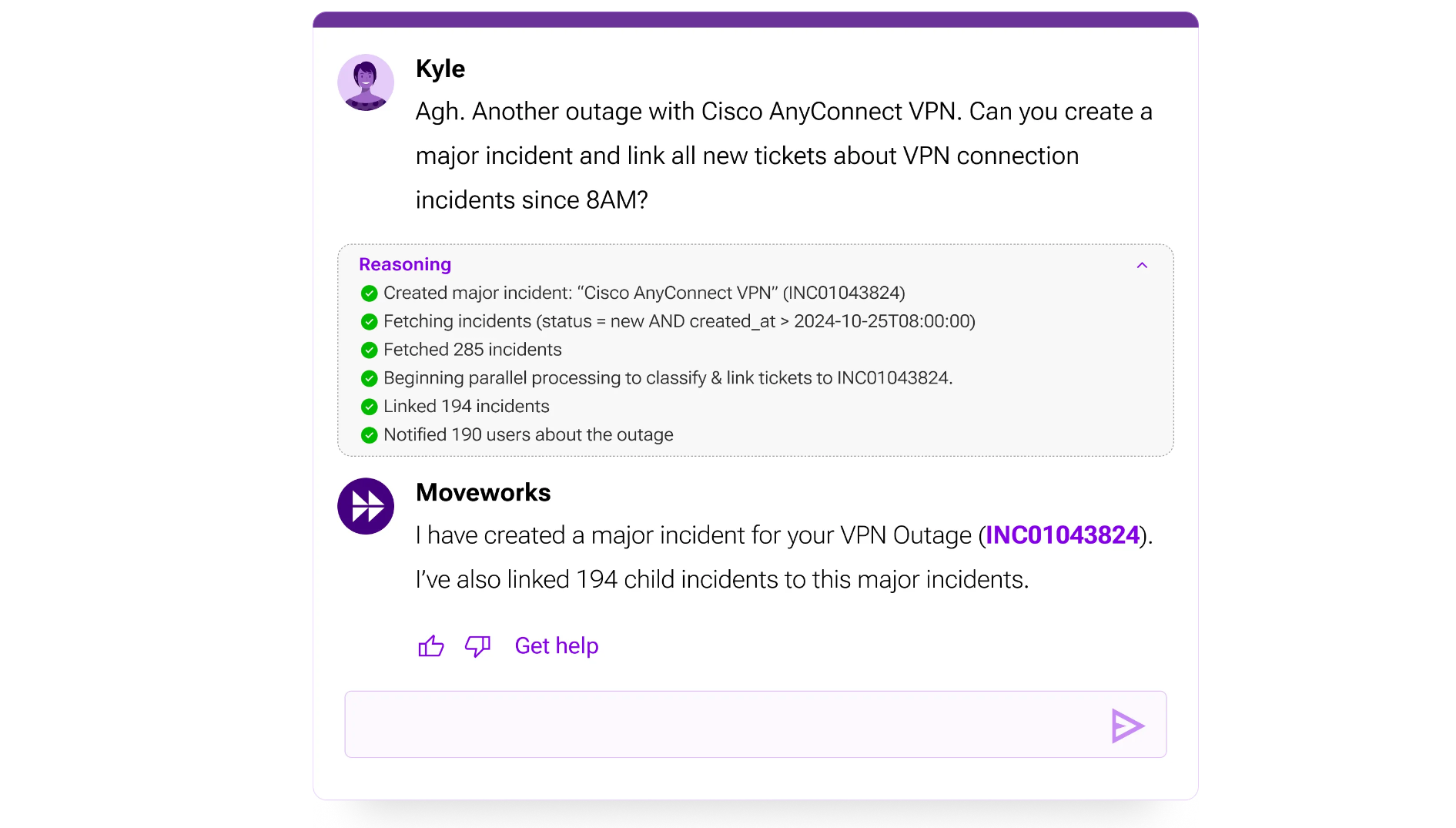
With our Agentic Automation Engine, IT professionals could hardly be more efficient. Here's how:
Slot Resolvers collects requirements to create a major incident (title = “Cisco AnyConnect VPN Outage”, owner=Kyle)
Slot Resolvers determine the filtering criteria for child incidents (status = ‘new’, created_at > 2024-10-25T08:00:00)
The Action Orchestrator uses a “for loop” control flow to paginate over the ServiceNow APIs and retrieve all tickets that meet the criteria
The Action Orchestrator uses “parallel processing” control flow to process each ticket that met the criteria. This completes the task much faster.
The Action Orchestrator uses LLM actions to classify each ticket as related to the major incident based on the ticket description.
The Action Orchestrator uses notification actions to inform the employees who filed the tickets that their ticket is related to the outage.
The Action Orchestrator keeps the incident manager apprised throughout the process with progress updates.
Developers who want to build this themselves outside of Moveworks Agent Studio would have had to write an inordinate amount of code and get access to heavy-duty infrastructure.
- Developers would need an API key for using LLMs to classify each tickets.
- Developers would need to implement rate limiting for those LLM calls.
- Developers would need to write multi-threading logic.
- Developers would need to manage notifications and rate limits for every ticket that’s been linked.
Want AI agents in your enterprise?
At Moveworks, we don’t celebrate plugins until our customers get them into production. We’re very excited about everything that our customers have built with the Agentic Automation Engine in a few short weeks – but we hold a high bar for the products we ship and the impact customers get from them.
That’s why we were so thrilled to see this email come in shortly after the hackathon from one of our attendees.
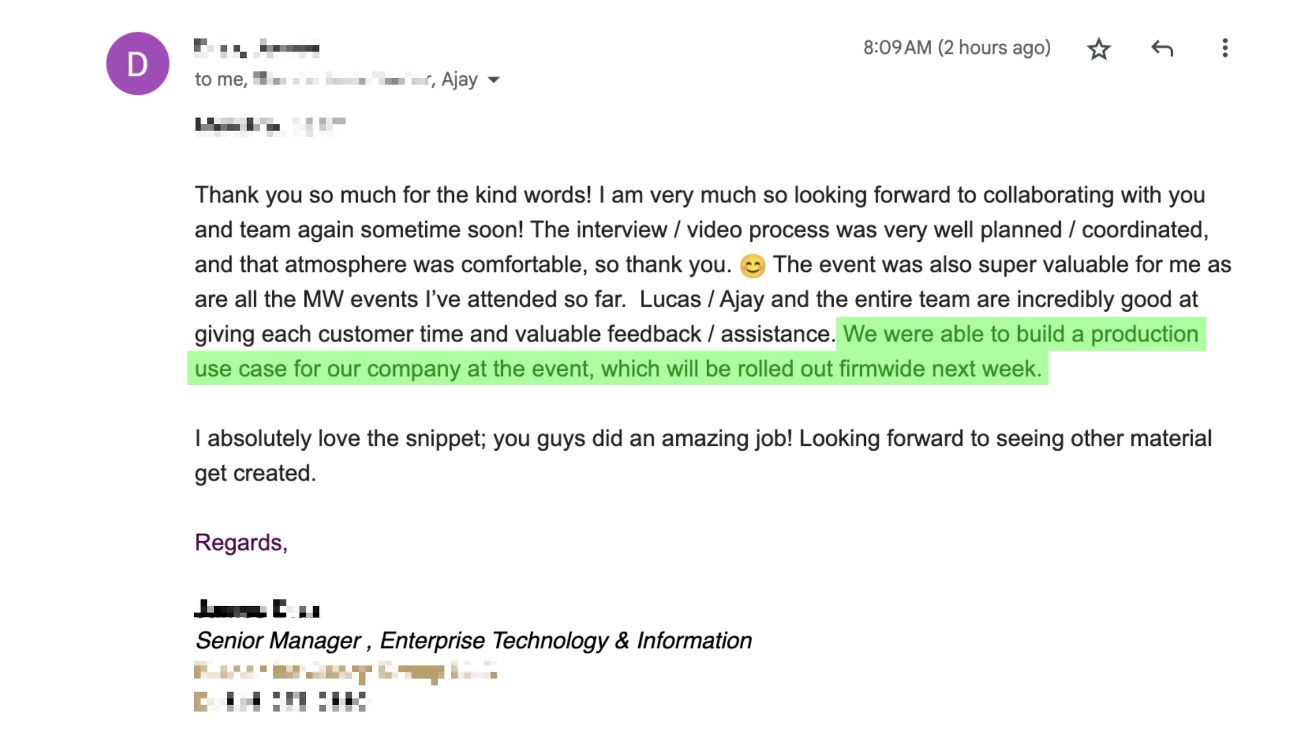
The first AI agents built on the Agentic Automation Engine are already hitting production. When it comes to AI agents, we believe the only limit is your imagination, so now it's time to stop dreaming – and start building.
Want to get started? Sign-up for our AI Activate Program and our Professional Services team will help you deploy plugins for the most popular business systems.
